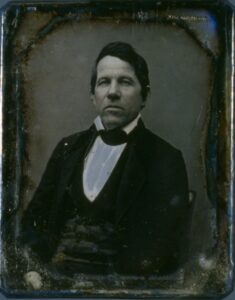 Edward Allen Hannegan was one of the most prominent and charismatic politicians in Indiana from the 1830s through the 1850s. He was born in Hamilton County, Ohio in 1807 and moved to Bourbon County, Kentucky as an infant with his family. He was admitted to the bar in 1827 after graduating from Transylvania College in Kentucky and moved to Indiana. He moved a couple of times before settling in Covington. He became a Mason and in 1829, he married Margaret Chambers Duncan. He and Margaret had one son, Sellman Key Hannegan, born in 1832.
Edward Allen Hannegan was one of the most prominent and charismatic politicians in Indiana from the 1830s through the 1850s. He was born in Hamilton County, Ohio in 1807 and moved to Bourbon County, Kentucky as an infant with his family. He was admitted to the bar in 1827 after graduating from Transylvania College in Kentucky and moved to Indiana. He moved a couple of times before settling in Covington. He became a Mason and in 1829, he married Margaret Chambers Duncan. He and Margaret had one son, Sellman Key Hannegan, born in 1832.
He was a gifted speaker—brilliant and eloquent—and was called the “[Daniel] Webster of the West.” A Democrat in his political career, he served in the Indiana House of Representatives followed by election to Congress for both the 23rd and 24th Congresses (serving from 1833 through 1837). He then served in the U.S. Senate from 1842 to 1849. He was not re-nominated in 1848 for the Senate. In 1849, he ran for governor and lost but was then appointed U.S. Minster to Prussia by the Polk administration. There was a rumored infatuation by the Queen Consort of Prussia with the handsome Hannegan. At the conclusion of his service in Prussia he returned to Covington to practice law. There was talk that he might be presidential material.
As brilliant and eloquent as Hannegan was he was also erratic, and he had a drinking problem. On May 6, 1852, Lew Wallace and Susan Elston were married in Crawfordsville. On that same night of May 6 at 505 Washington Street in Covington, Hannegan used his cane dagger to kill his brother-in-law, Captain John R. Duncan. A Captain who had served honorably in the Mexican War, Duncan had confronted Hannegan about his heavy drinking. As he lay dying, Duncan pleaded with those present to not prosecute his brother-in-law.
Lew Wallace was the prosecuting attorney in Covington at the time and a close friend of the popular Hannegan. Stories have circulated that Wallace presented such a weak case that the Grand Jury refused to indict Hannegan. These same stories say that Wallace was so roundly criticized for his poor performance that he was forced to resign as prosecutor and moved to Crawfordsville to continue his career. Actually, when Wallace ran for reelection in October of 1852, after the Hannegan case, he won his race by 1,232 votes to 150 for his opponent. The vote in Fountain (Covington) County alone was 632 for Wallace and 4 for his opponent. The move to Crawfordsville seems to have had more with Wallace looking for increased job prospects and Susan’s desire to live closer to her family.
After Wallace left, his appointed replacement was his close friend at the time, Daniel Voorhees. Voorhees held the cane used by Hannegan as evidence in the murder case, but he ultimately decided not to have the Grand Jury review the case. The case was then referred to Judge Isaac Naylor, who dismissed it in 1852. When Voorhees departed Covington, he left the cane with the Sheriff in Covington and the cane passed down through that family until it was donated to the Indiana State Museum in 1947.
By 1857, Wallace had already left Covington. In that year, both Voorhees and Hannegan also left Covington. A Democrat, Voorhees became District Attorney for Indiana from 1858 through 1861. During the Civil War he served as a congressman. He served again in Congress in the late 1860s and then served as a powerful Senator from 1877 until his death in Washington in 1897. While Voorhees became one of Indiana’s most storied politicians and Lew Wallace went on to great things, Hannegan’s life took another track. In 1857, he left Covington and moved to St. Louis, Missouri where is son was living. On February 25, 1859, he died from an overdose of morphine; a likely suicide and a sad end for a man who did much to promote Indiana on the national stage for almost 20 years. He is buried in Woodlawn Cemetery in Terre Haute.
Thanks to Rachel Perry at the Indiana State Museum for this information and to Joann Spragg for her research.
Museum’s Vision
The General Lew Wallace Study and Museum celebrates and renews belief in the power of the individual spirit to affect American history and culture.
Museum’s Mission
The General Lew Wallace Study & Museum is deeply committed to the protection and preservation of Lew Wallace’s legacy now and for generations to come.